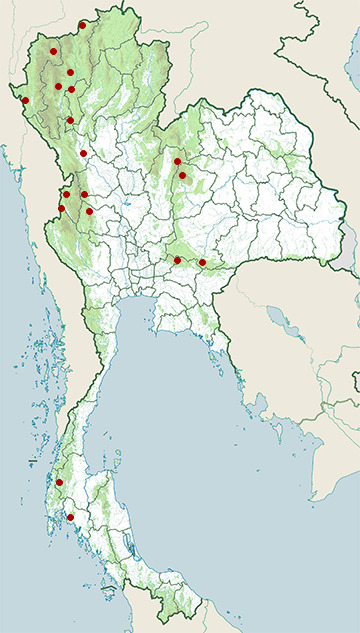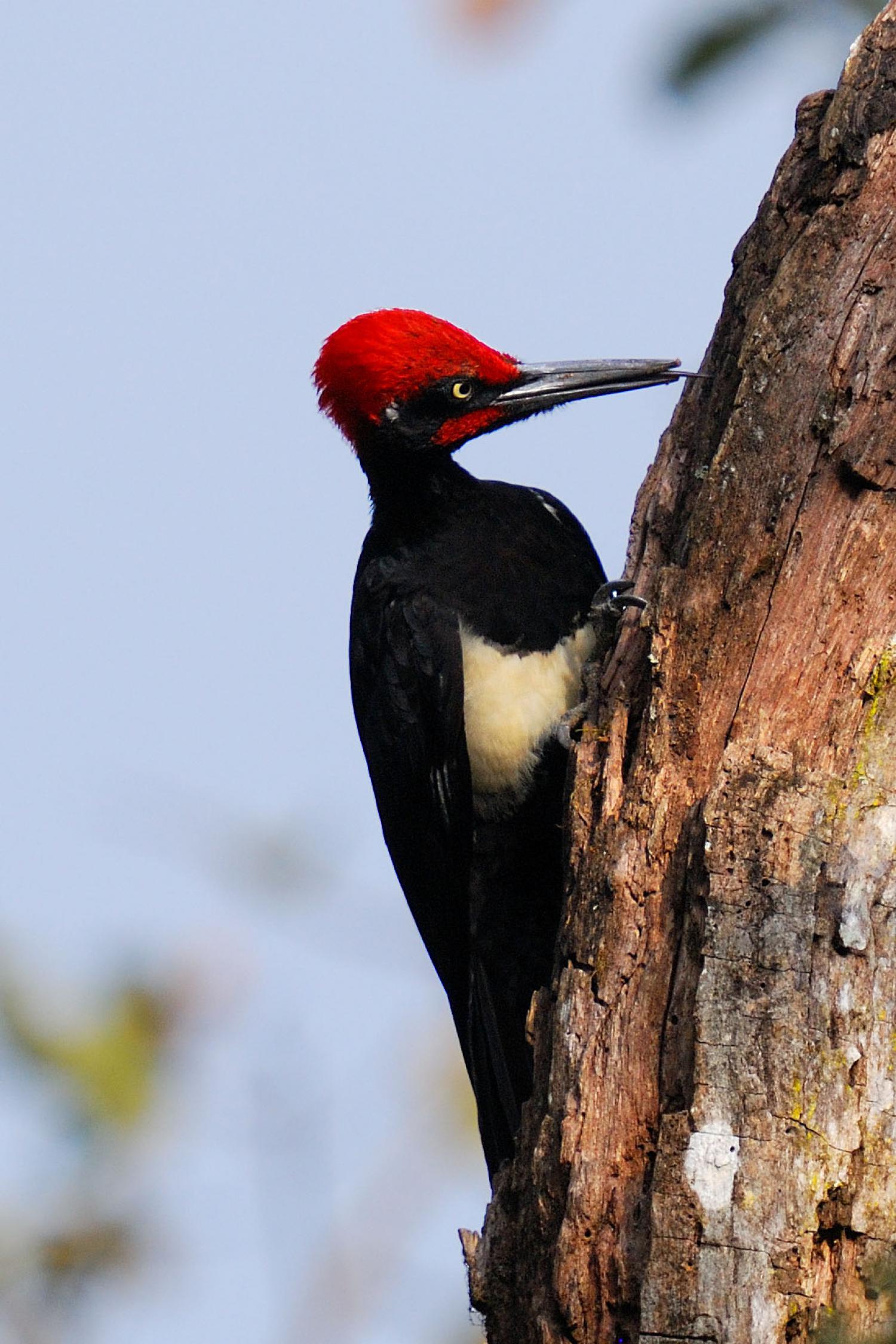Species of Thailand
White-bellied woodpecker
Dryocopus javensis
Thomas Horsfield, 1821
In Thai: นกหัวขวานใหญ่สีดำ
The white-bellied woodpecker or great black woodpecker (Dryocopus javensis) is found in evergreen forests of tropical Asia, including the Indian subcontinent and Southeast Asia. It has 14 subspecies, part of a complex including the Andaman woodpecker (Dryocopus hodgei) (earlier treated as a subspecies). Many island forms are endangered, some are extinct. Populations differ in the distribution and extent of white. They are among the largest of the Asiatic woodpeckers and nest in large dead trees, often beside rivers. Their drums and calls are louder than those of the smaller woodpeckers.
Description
This species is one of the largest living species of woodpecker. Adults range in size from 40 to 48 cm and are second in size only to the great slaty woodpecker among Asian woodpecker species. The species is considered closely related to the more northern black woodpecker and the North American pileated woodpecker and is similar in size to these species. Body mass can vary from 197 to 350 g. Among standard measurements, the wing chord is 20.5 to 25.2 cm, the tail is 14.3 to 18.9 cm, the bill is 4.6 to 6 cm and the tarsus is 3.2 to 4.3 cm.
The subspecies hodgsonii has whitish underwing coverts and a white rump. The face lacks white, but juveniles of the nominate race can have white streaks on the throat. Differences from the other Southeast Asian subspecies in the vocalizations and morphology of this species are suggested to be large enough to raise this to full species status. Solitary adults may spend an hour foraging at a suitable tree. The subspecies hodgsonii of India breeds from January to May, mainly in large dead trees, often using the same tree year after year. The normal clutch is usually of two eggs. They feed mainly on insects such as ants or grubs obtained mainly from under bark, but sometimes take fruit. Although shy, they can nest close to well-used tracks and human disturbed areas. They have a range of calls from a short, sharp "kuk" to more intoned "kyuk", "kew", "kee-yow" calls. The longer calls are given prior to flying off. They roost within holes.
Subspecies
Fourteen subspecies have been described:
- D. j. javensis (Horsfield, 1821) (southern Thailand to Borneo)
- D. j. philippinensis (Steere, 1890) (the Philippines; more often subsumed into the nominate subspecies)
- D. j. cebuensis Kennedy, 1987 (Cebu Island)
- D. j. confusus (Stresemann, 1913) (Luzon; includes esthloterus (Parkes, 1971))
- D. j. feddeni (Blyth, 1863) (Thailand, Laos and Burma)
- D. j. forresti Rothschild, 1922 (northern Myanmar and Sichuan, China)
- D. j. hargitti (Sharpe, 1884) (Palawan)
- D. j. hodgsonii (Jerdon, 1840) (mainly the Western Ghats of India, but also known from central India and the Eastern Ghats)
- D. j. mindorensis (Steere, 1890) (Mindoro)
- D. j. multilunatus (McGregor, 1907) (Basilan, Dinagat, Mindanao)
- D. j. parvus (Richmond, 1902) (Simeulue Island)
- D. j. pectoralis (Tweeddale, 1878) (Samar, Bohol and other islands)
- D. j. richardsi (Tristram, 1879) (Tristram's woodpecker; found only in North Korea, extinct in South Korea and Tsushima, Japan)
- D. j. suluensis (W. Blasius, 1890) (Sulu)
The Andaman woodpecker (Dryocopus hodgei) was treated as a subspecies in the past. The species has in the past been placed in the genus Thriponax and Macropicus.
Behaviour and ecology
This large black woodpecker is usually seen singly or as a pair, which may sometimes be accompanied by a third bird. They have a dipping in which the loud single note, a laugh-like chiank call, is produced. They also produce loud drumming, especially in the breeding season. The breeding season is mainly January to March. The nest is built in a large dead tree, often in open forest. Two white eggs are the usual clutch. In Bastar in central India, the squabs are sought after by tribals, resulting in the rarity of these birds there.
This article uses material from Wikipedia released under the Creative Commons Attribution-Share-Alike Licence 3.0. Eventual photos shown in this page may or may not be from Wikipedia, please see the license details for photos in photo by-lines.
Category / Seasonal Status
BCST Category: Recorded in an apparently wild state within the last 50 years
BCST Seasonal status: Resident or presumed resident
Scientific classification
- Kingdom
- Animalia
- Phylum
- Chordata
- Class
- Aves
- Order
- Piciformes
- Family
- Picidae
- Genus
- Dryocopus
- Species
- Dryocopus javensis
Common names
- Thai: นกหัวขวานใหญ่สีดำ
Subspecies
Dryocopus javensis cebuensis, Robert S. Kennedy, 1987
Range: Cebu Island
Dryocopus javensis confusus, Erwin Stresemann, 1913
Range: Luzon, includes D. j. esthloterus (Kenneth Carroll Parkes, 1971)
Dryocopus javensis feddeni, Edward Blyth, 1863
Range: Thailand, Laos and Burma
Dryocopus javensis forresti, Lionel Walter Rothschild, 1922
Range: Northern Myanmar and Sichuan, China
Dryocopus javensis hargitti, Richard Bowdler Sharpe, 1884
Range: Palawan
Dryocopus javensis hodgsonii, Thomas Caverhill Jerdon, 1840
Range: Found mainly in the Western Ghats of India but also known from central India and the Eastern Ghats.
Dryocopus javensis javensis, Thomas Horsfield, 1821
Range: Southern Thailand to Borneo
Dryocopus javensis mindorensis, Joseph Beal Steere, 1890
Range: Mindoro
Dryocopus javensis multilunatus, Ernest Alexander McGregor, 1907
Range: Basilan, Dinagat, Mindanao
Dryocopus javensis parvus, Charles Wallace Richmond, 1902
Range: Simeulue Island
Dryocopus javensis pectoralis, Arthur Hay, A.K.A. Viscount Walden, 1878
Range: Samar, Bohol and other islands
Dryocopus javensis philippinensis, Joseph Beal Steere, 1890
Range: More often subsumed into the nominate
Dryocopus javensis richardsi, Henry Baker Tristram, 1879
Range: Tristram's woodpecker found in Korea, extinct on Tsushima
Dryocopus javensis suluensis, Wilhelm August Heinrich Blasius, 1890
Range: Sulu
Conservation status

Least Concern (IUCN3.1)

Critically Endangered (ONEP)
- CR (javensis)/NT (feddeni) -

Near Threatened (BCST)
Photos
Please help us review the bird photos if wrong ones are used. We can be reached via our contact us page.
Range Map

- Doi Inthanon National Park
- Doi Pha Hom Pok National Park
- Doi Suthep - Pui National Park
- Huai Kha Khaeng Wildlife Sanctuary
- Khao Sok National Park
- Khao Yai National Park
- Mae Ping National Park
- Mae Wong National Park
- Mueang Krabi District, Krabi
- Mueang Tak District, Tak
- Nam Nao National Park
- Pa Sang District, Lamphun
- Pai District, Mae Hong Son
- Phu Khiao Wildlife Sanctuary
- Salawin National Park
- Thap Lan National Park
- Thung Yai Naresuan Wildlife Sanctuary
- Umphang Wildlife Sanctuary
